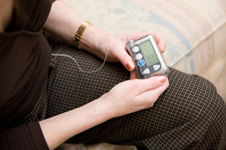In this section, you will find information on:
Extended bolus
What is it?
An amount of mealtime bolus insulin equally spread and delivered over a specific amount of time.
What can it do?
When eating foods that are high in fat or protein, or if you take pramlintide with a meal, you may benefit from insulin delivered over a longer amount of time. High fat and protein meals and pramlintide cause food to be retained in the stomach and only very slowly digested. This can result in a low blood sugar in the early post meal period when the bolus insulin is active, followed by a high blood sugar when the food finally is abosrbed. The use of an extended bolus makes less insulin available early in the meal and more available later – so there is a better match with the food absorption.

The insulin pump or continuous subcutaneous insulin infusion device (CSII) continuously administers rapid acting insulin into the fatty tissue beneath the skin. The insulin pump is especially suited to covering different patterns of insulin resistance or sensitivity throughout the day. The pump also has multiple bolus profiles including standard, dual, multiple and extended boluses.
Dual bolus
What is it?
A combination of immediate bolus insulin delivery, plus an extended bolus.
What can it do?
A dual bolus provides insulin coverage for foods that contain both high fat or high protein with simple carbohydrates.
Insulin-on-board (IOB)
What is it?
IOB is a program that keeps track of how long a bolus of insulin is working, so you can adjust your next insulin bolus to prevent overlapping insulin effect from multiple boluses. You set your IOB for a certain amount of time. Depending upon the dose of rapid-acting insulin (analog insulin), it is usually set for 4 hours. Individuals with expecially high bolus doses, i.e. over 15-20 units per bolus, may need an IOB of 5-6 hours.
What are the benefits of this pre-programming?
- Helps prevent “stacking” insulin, or excessive correction of a high glucose, that can result in hypoglycemia
- Helps avoid giving too little insulin in treating high glucose for fear of hypoglycemia
Example
- 2 p.m. glucose: 250 mg/dl (entered by user)
- IOB shows: 2.3 units still effective (from previous bolus delivered at lunch)
- ISF: 1 unit per 50
- Target glucose: 110 mg/dl
- Calculation: 250 minus 110 = 140
- 140 divided by 50 = 2.8
- 2.8 minus 2.3 = .5
- Recommendation: 0.5 unit for a high glucose of 250 at 2 p.m.
Self-assessment Quiz
Self assessment quizzes are available for topics covered in this website. To find out how much you have learned about Insulin Pumps, take our self assessment quiz when you have completed this section. The quiz is multiple choice. Please choose the single best answer to each question. At the end of the quiz, your score will display. If your score is over 70% correct, you are doing very well. If your score is less than 70%, you can return to this section and review the information.
